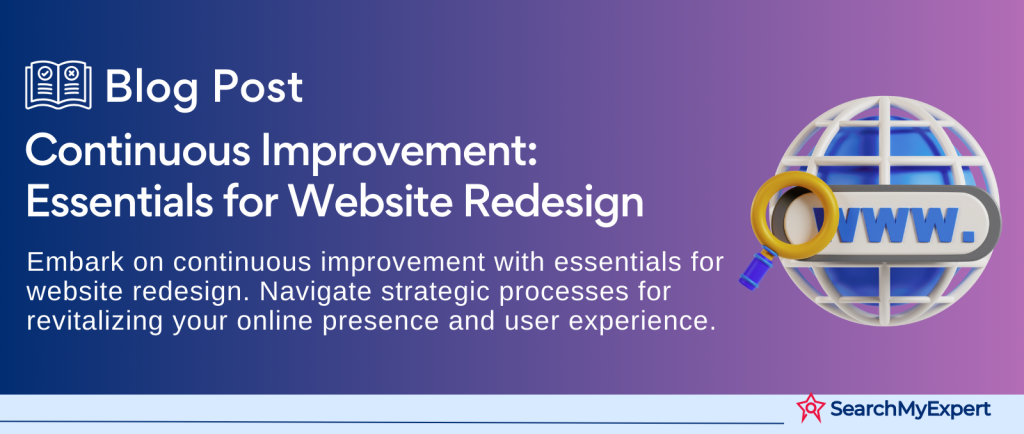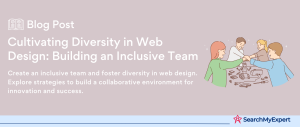Assess Your Needs and Goals: Crafting the Foundation for a Stellar Website Redesign
Unveiling the Core of Your Website’s Performance
The Art of Understanding User Data
User data is the compass that guides your website’s journey. It offers a panoramic view of who your users are, what they prefer, and how they interact with your site. This data isn’t just numbers and charts; it’s a story about your audience’s journey on your website. Understanding this narrative is crucial in shaping a website that not only attracts but also retains users.
Traffic Metrics: The Pulse of Your Website
Traffic metrics are like the vital signs of your website. They reveal the health and performance of your site. Metrics such as page views, bounce rates, session duration, and conversion rates are not just statistics; they are indicators of user engagement and content effectiveness. A high bounce rate, for instance, might suggest that your site is not delivering what the users expected, prompting a need for content or design re-evaluation.
The Power of User Feedback
Feedback is the unfiltered voice of your customers. It offers direct insights into what users love and what they find lacking. Analyzing feedback helps in pinpointing specific areas of your website that need improvement. This could range from navigational issues to content relevance, and even technical glitches. User feedback is invaluable in making informed decisions during the redesign process.
Defining Business Objectives for the Redesign
Setting Clear, Achievable Goals
A website redesign without clear business objectives is like sailing without a compass. The goals you set should align with your overall business strategy. Are you aiming for higher sales, increased brand awareness, or improved lead generation? These objectives dictate the direction of your redesign strategy.
Measurable Objectives: The Key to Success
Setting measurable goals is crucial. It’s not enough to aim for ‘more sales’; quantifying your goals, like aiming for a 20% increase in sales or a 30% boost in lead generation, gives you a clear target to hit. These measurable objectives also provide a benchmark to evaluate the success of your redesign post-launch.
Delving Deep into User Understanding
Researching the Target Audience
Crafting User Personas: A Window into Your Audience’s Soul
Understanding your target audience goes beyond mere demographics. It involves delving into their interests, online behaviors, and preferences. Creating detailed user personas helps in visualizing the ideal visitor to your website. These personas become the blueprint in designing a user-centric website that resonates with your audience.
Behavioral Insights: Tailoring Your Website to User Preferences
Analyzing user behavior on your website offers critical insights into their preferences. What pages do they visit most? What content keeps them engaged? This information is instrumental in shaping a website that caters to the needs and preferences of your target audience.
The Importance of User Testing
Real-Time Insights: Observing User Interaction
User testing involves observing real users as they interact with your website. This hands-on approach allows you to witness firsthand the user experience of your website. It’s an opportunity to identify any hurdles or friction points that users encounter.
Identifying Opportunities for Improvement
Through user testing, you can pinpoint specific areas where your website falls short. These might be navigation issues, content irrelevance, or technical problems. Identifying these pain points is the first step towards making meaningful improvements in your website redesign.
Blueprint for Success
Developing a Robust Content Strategy
Crafting an Information Architecture That Speaks to Users
Information architecture is the backbone of your website. It’s not just about organizing content; it’s about making it accessible and intuitive for your users. This process involves mapping out how information is presented on your website, ensuring that it aligns with user expectations and business goals. Think of it as creating a roadmap for your users, guiding them effortlessly to the information they seek.
Prioritizing Content: Balancing User Needs and Business Goals
Content is king, but context is queen. Prioritizing content means not only creating high-quality, engaging material but also aligning it with what your users want and your business needs. It’s about striking a balance between what your users are looking for and what you want to convey. This prioritization ensures that your most important messages are front and center, capturing user attention and driving engagement.
Choosing the Right Design Platform
The Role of a Content Management System (CMS)
Selecting a CMS is a critical decision in your website redesign process. The right CMS can empower your team, offering flexibility and scalability to meet your evolving needs. It should be user-friendly, allowing easy updates and management of content, and robust enough to handle your website’s growing demands.
Flexibility and Scalability: Key Considerations
When choosing a CMS, consider not only your current needs but also future growth. Look for a platform that offers customization options to tailor the site to your unique requirements and scalability to accommodate increased traffic and content as your business grows.
Designing for an Exceptional User Experience (UX)
Prioritizing Usability: A User-Centric Approach
Navigational Clarity is Paramount
A website should be more than aesthetically pleasing; it should be a breeze to navigate. Usability is about making it effortless for users to find what they need. This involves intuitive navigation, clear menus, and a structure that feels natural to the user. A user-friendly website reduces frustration and enhances the overall experience, encouraging longer visits and repeat users.
Task Completion: Smooth and Simple
The ease with which users can complete tasks on your site, whether it’s making a purchase, signing up for a newsletter, or finding information, is a key component of usability. This involves streamlining processes and minimizing steps to complete a task, enhancing the user’s journey through your site.
Optimizing for Mobile: A Necessity in Today’s Digital World
The Rise of Mobile Browsing
With the increasing prevalence of smartphones, designing for mobile is no longer optional; it’s essential. A responsive website adapts to various screen sizes and devices, ensuring a seamless experience whether users are on a desktop, tablet, or smartphone. This adaptability is crucial in capturing and retaining the ever-growing mobile audience.
Consistency Across Devices
Responsive design is about providing a consistent experience across all devices. This means not only resizing content but also considering the functionality and usability on different screens. The goal is to ensure that users have a positive experience, regardless of how they access your site.
Focusing on Visual Hierarchy: Guiding the User’s Eye
The Power of Clear Layouts and Typography
Visual hierarchy is the art of arranging elements in a way that naturally guides the user’s eye through the content. This involves using layouts, typography, and visuals to create a clear path for the user. Well-designed visual hierarchy makes it easier for users to process information and understand where to focus their attention.
Effective Use of Visual Elements
Using visuals effectively means more than just aesthetics; it’s about communication. The right visuals can draw attention, evoke emotions, and enhance the overall message of your content. This includes the thoughtful use of images, colors, and graphical elements to create a cohesive and engaging user experience.
From Blueprint to Reality
Developing the Website According to the Design Plan
Translating Design into Functionality
The development phase is where the design plan comes to life. It involves translating the visual mockups, wireframes, and prototypes into a fully functioning website. This process requires a harmonious blend of front-end and back-end development skills, ensuring that the visual appeal of the design is matched by robust functionality and performance.
Collaboration Between Designers and Developers
A seamless transition from design to development is crucial. This requires effective communication and collaboration between designers and developers. Designers need to convey the intent and nuances of the design, while developers must translate these into practical, efficient code. It’s a symphony of skills, with each team member playing a vital role in the site’s creation.
Testing Functionality and Compatibility
Ensuring Cross-Browser Compatibility
Testing for cross-browser compatibility ensures that your website functions and appears as intended across various web browsers, such as Chrome, Firefox, Safari, and Edge. This step is critical because different browsers can interpret website code differently, leading to variations in how your site is displayed. The goal is to offer a consistent user experience regardless of the browser choice.
Device Compatibility: Embracing the Mobile World
In an era dominated by smartphones and tablets, testing for device compatibility is non-negotiable. This involves ensuring that the website is responsive, adapting its layout and functionality seamlessly to different screen sizes and orientations. The focus is on delivering a fluid, user-friendly experience across all devices.
Addressing Technical Issues and Bugs
The Bug Hunt: A Critical Step Before Launch
Before the website goes live, a thorough bug hunt is essential. This involves identifying and fixing any technical issues, glitches, or errors that could hinder the user experience. Bug hunting is a meticulous process, often involving multiple rounds of testing and revisions.
Pre-Launch Checklist: Dotting the I’s and Crossing the T’s
As the website nears completion, a pre-launch checklist helps ensure that no detail is overlooked. This includes finalizing content, optimizing performance, ensuring SEO readiness, and confirming security measures. It’s the final quality assurance step, ensuring that the website is polished, professional, and ready for its debut.
The Role of Quality Assurance in Web Development
Maintaining High Standards Throughout the Process
Quality assurance (QA) plays a pivotal role throughout the website development process. It’s not just about testing at the end; it’s an ongoing commitment to excellence. QA involves regular checks and balances, ensuring that each phase of development adheres to predetermined standards and best practices.
Collaborative Effort Between QA and Development Teams
Effective QA requires a collaborative effort between the QA team and the developers. Regular communication and feedback loops help identify issues early on, allowing for timely corrections. This partnership is key to maintaining a high standard of quality throughout the development process.
User-Centric Focus: Meeting and Exceeding Expectations
At the heart of QA is a user-centric focus. It’s about ensuring that the website not only functions flawlessly but also delivers a superior user experience. This means paying attention to details like load times, ease of navigation, and overall usability. A website that excels in these areas is more likely to engage and retain users.
Unveiling Your Redesigned Website
Planning a Smooth Launch Strategy
The Countdown to Launch
A successful website launch is more than just flipping a switch; it’s a meticulously planned event. A smooth launch strategy involves final checks, coordination with marketing teams, and a well-defined communication plan. It’s about ensuring that all stakeholders are aligned, and the necessary support systems are in place to handle any unforeseen issues.
Communication Plan: Keeping Everyone in the Loop
Clear communication is key during a website launch. This involves informing both internal teams and external audiences about the launch timeline. Marketing and PR teams play a crucial role in crafting messages that create buzz and excitement around the new website. Communication channels such as email newsletters, social media, and press releases are leveraged to announce the launch.
Tracking Website Performance Using Analytics Tools
The Power of Data
Once the website is live, tracking its performance is vital. Analytics tools like Google Analytics provide a wealth of data about user behavior, traffic sources, engagement metrics, and conversion rates. This data is not just numbers; it’s the story of how users are interacting with your site, offering insights into what’s working and what needs improvement.
Making Data-Driven Decisions
The insights gained from analytics are invaluable in making informed decisions. They help in understanding user pathways, identifying popular content, and spotting trends. This data-driven approach allows for continuous optimization of the website to better meet user needs and business objectives.
Gathering User Feedback and Iterating
The Importance of User Feedback
Post-launch, gathering user feedback is essential. Tools like surveys, feedback forms, and usability testing offer direct insights from users. This feedback is a treasure trove of information, providing real-world perspectives on the website’s usability, content relevance, and overall experience.
Iterating Based on Insights
The launch is just the beginning. The real journey starts with iterating and refining the website based on user feedback and data. It’s a continuous cycle of improvement, ensuring that the website remains relevant, user-friendly, and aligned with evolving user expectations and business goals.
Ensuring Continuous Growth and Relevance
Regular Content Updates and Feature Additions
Keeping the Website Fresh and Engaging
A static website is a stagnant website. Regularly updating content and adding new features keeps the website dynamic and engaging. This involves not only updating existing content but also introducing new articles, blog posts, videos, and interactive elements. It’s about keeping the content fresh, relevant, and aligned with current trends and user interests.
The Evolution of Features
Adding new features and functionalities is crucial in keeping the website at the forefront of technology and user expectations. This could include implementing new e-commerce capabilities, chatbots for improved customer service, or interactive tools that enhance user engagement.
Staying Abreast with Design Trends and Technologies
Embracing New Trends
The digital landscape is ever-evolving, and staying informed about new design trends and technologies is crucial. This involves keeping an eye on emerging design patterns, user interface improvements, and technological advancements. Adapting to these changes ensures that the website remains modern, relevant, and competitive.
The Balance Between Trends and Usability
While embracing new trends is important, it’s equally crucial to maintain a balance. The latest design fads should not come at the cost of usability and user experience. The key is to integrate new trends in a way that enhances, rather than hinders, the user journey on your website.
Continuously Improving Based on User Feedback and Data
The Ongoing Cycle of Enhancement
A website is a living entity that requires ongoing attention and improvement. Regularly reviewing user feedback and analytics data helps in identifying areas for enhancement. This could involve refining the user interface, optimizing the site for search engines, or enhancing the mobile experience.
Data as the Guiding Light
Data should be the guiding light in the journey of continuous improvement. It provides objective insights into user behavior, preferences, and pain points. Leveraging this data ensures that every update, feature addition, or design change is grounded in real user needs and preferences.
Conclusion
Launching and monitoring a redesigned website is a critical phase that sets the stage for its long-term success. It involves careful planning, continuous tracking of performance, and iterating based on user feedback and data. The journey doesn’t end with the launch; it evolves into a cycle of maintenance and continuous improvement, ensuring the website stays relevant, engaging, and aligned with the latest trends and technologies.
Build a website that wows with Web Design Companies.
Table of Contents
Toggle






